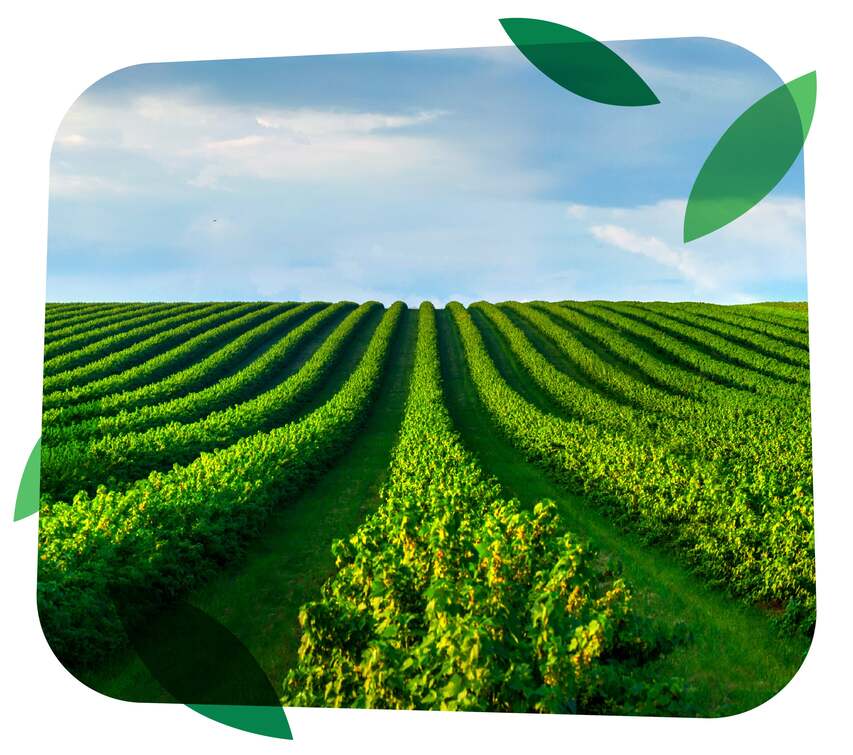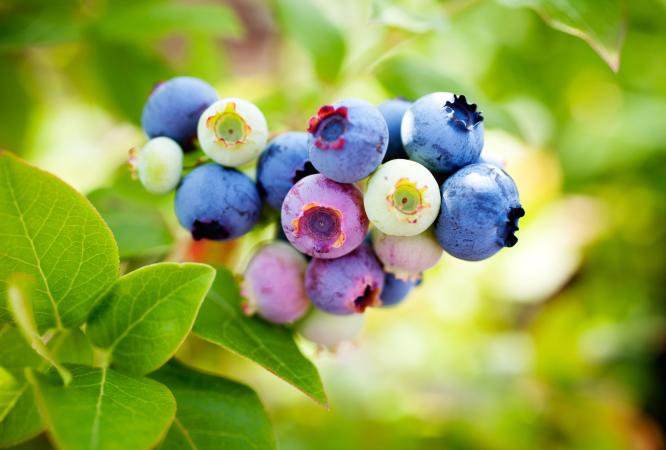Nutrition of blueberries: general rules
♦ When setting the application rates, consider expected yield and required balance of nutrients
♦ Provide complete fertilization, with macro- and micro-nutrients
♦ Consider cation ratios Ca/K, Ca/Mg, Ca/(K+Mg)
♦ Consider NH4/NO3 ratio. The majority of nitrogen should be supplied as nitrate
♦ Use soluble and chloride-free potassium
♦ Use diagnostic tools such as soil analysis, foliar, suction probes, chlorophyll meters, etc.
♦ Split applications according to the plant’s uptake dynamics
Berries hate salinity:
Berry type | EC (dS / m) at which the yield decreased by: | ||
| 10% | 25% | 50% |
Blackberry | 1.5 | 2.0 | 2.5 |
Blueberry | 1.0 | 1.5 | 2.0 |
Raspberry | 1.5 | 2.0 | 2.5 |
Considerable yield reduction occurs at relatively low EC levels.
Nitrogen Deficiency:
- Nitrogen leaching, resulting from intensive rains or excessive irrigation, is a common cause of deficiencies
- Typical symptoms: small pale leaves, sometimes with tiny red spots
- Blueberries are salt-sensitive, so excessive N fertilization may cause mortality of young plants
- Ammonium is the preferred form of nitrogen for blueberries
- Ammonium nitrate can be used in fertilizer mixes:
- Where the nitrate portion of the mix constitutes a minor part of the total nitrogen in the mix and the soil pH is below 5.3.
- For very light (20 pounds per acre or less) applications of nitrogen where a small amount of nitrogen is needed.
- Urea and controlled release fertilizers are also suitable sources of nitrogen for blueberries
- In the soil, urea is a rapidly converted to ammonium, which is readily absorbed by the plant
- In soils where the pH is on the high end of the range for blueberries (above 5.0), use a more acid-forming fertilizer such as ammonium sulfate
Timing of nitrogen applications for blueberries in Alabama

Phosphorus in Blueberries:
- Phosphorus is very important for the root establishment and for energy transfer in the plant
- Many blueberry fields are low in P:
- In acidic soils P availability is low
- In sandy soils P is prone to leaching
- Pre-plant application of P is advisable
- High levels of phosphorus in the soil can tie up iron, making it unavailable to the blueberry plant
Recommended application rates
Application rate | Soil test P (0-45 cm / 0-12”) | |||
Lb/acre | Kg/ha | NaHCO3 | Bray I | NaOAc |
100 | 112 | 0-4 | 0-10 | 0-1 |
80 | 90 | 4-8 | 10-20 | 1-2 |
60 | 67 | 9-11 | 20-30 | 2-3 |
30 | 34 | 12-14 | 30-40 | 3-4 |
10 | 11 | 15-17 | 40-50 | 4-5 |
0 |
| 18-25 | 50-100 | 5-10 |
0 |
| Over 25 | Over 100 | Over 10 |
Potassium in blueberry:
- Potassium is essential for photosynthesis and water regulation.
- On bearing plants, the annual potassium requirements can be supplied by 1-2 applications
Potassium recommended rates:
Application rate | Soil test K * Soil extract | |
Lb/acre | Kg/ha | |
80 | 90 | 0-50 ppm |
50 | 56 | 50-75 ppm |
30 | 34 | 75-100 ppm |
0 | 0 | Over 100 |
- For established plants, determine K application rates according to soil analysis
- In general:
- To correct shortage apply 113-224 kg/ha (100-200 lbs/acre) K2O
- To maintain adequate level apply 56-113 kg/ha (50-100 lbs/acre) K2O
Secondary elements:
- Blueberries have low calcium requirement
- Excessive calcium may cause iron deficiency
- Liming
- Only when soil pH is below 3.6
- Lime application rate: 560 kg/ha (500 lbs/acre)
- Do not exceed this rate

On highbush blueberries, classic magnesium deficiency is a green "Christmas Tree"
in the center of a chlorotic leaf.
It usually occurs on the older leaves

On young rabbit-eye plants
magnesium deficiency is commonly shown as
pink edges and interveinal yellowing of leaves
Ca-Mg balance:
- Calcium - magnesium levels should be kept in balance

- The normal range is 1:8 to 1:10 (Mg:Ca)
- High calcium levels can induce magnesium deficiency
- To correct magnesium deficiency, apply 16.8 kg/ha (15 Lbs/acre) magnesium
Calcium and fruit quality
- Pre-harvest calcium sprays.
- Increase firmness of the berries
- Extend shelf-life
- Reduce Botrytis rot

Blueberry showing Ca deficiency (left); inside view, note corky area (right).
Iron in blueberry:
 ♦ Iron deficiencies is likely to occur when soil pH is too high
♦ Iron deficiencies is likely to occur when soil pH is too high
♦ The best treatment is lowering soil pH
♦ Foliar sprays of Iron chelate may alleviate some leaf symptoms but usually do not improve overall plant vigor
Nutrigation™ program for blueberries:
Recommended fertilizers (kg/ha) | Nutrients required (kg/ha) | Timing | ||||
A-S | K2O | P2O5 | N | |||
60 | 12 | 32 | 30 | 7 | 15 | Leaf emergence |
90 | 16 | 42 | 40 | 10 | 20 | Flowering |
110 | 21 | 53 | 50 | 13 | 25 | Fruit set |
110 | 20 | 53 | 50 | 12 | 25 | Fruit growth |
60 | 13 | 30 | 30 | 8 | 15 | Fruit maturation |
430 | 82 | 210 | 200 | 50 | 100 | Total |
Texas fertigation schedule for blueberries:
Grams/plant/week | Plant diameter | ||
K | P | N | |
0.5 | 0.5 | 1 | 1 |
0.75 | 0.75 | 1.5 | 2 |
1 | 1 | 2 | 3 |
1.2 | 1.2 | 2.5 | 4 and up |
Nitrogen fertigation for blueberries:
1.Reduce annual N rate by 1/3, compared to soil application
2.Start application 2-3 weeks after bud break, continue into July

Leaf analysis
Suggested critical levels of nutrients in highbush and rabbiteye blueberry leaves
Excess | Normal: rabbiteye | Normal: highbush | Deficiency | Nutrient |
2.5%< | 1.2-1.7% | 1.8-2.1% | < 1.7% | N |
0.8%< | 0.08-0.17% | 0.12-0.4% | < 0.1% | P |
0.95%< | 0.28-0.6% | 0.35-0.65% | < 0.3% | K |
1%< | 0.24-0.7% | 0.4-0.4% | < 0.13% | Ca |
0.45%< | 0.14-0.2% | 0.12-0.25% | < 0.08% | Mg |
NA | NA | 0.12-0.2% | < 0.1% | S |
Excess | Normal: rabbiteye | Normal: highbush | Deficiency | Nutrient |
450 ppm< | 25-100 ppm | 50-350 ppm | < 23 ppm | Mn |
400 ppm< | 25-70 ppm | 60-200 ppm | < 60 ppm | Fe |
80 ppm< | 10-25 ppm | 8-30 ppm | < 8 ppm | Zn |
100 ppm< | 2-10 ppm | 5-20 ppm | < 5 ppm | Cu |
200 ppm< | 12-35 ppm | 30-70 ppm | < 20 ppm | B |
Need more information about growing blueberries? You can always return to the blueberry fertilizer .




